Le Scrum board, ou tableau Scrum Agile, est un élément essentiel du cadre Scrum. En effet, cet outil est très simple d’utilisation, visuel et polyvalent. En outre, il permet de garder le bon cap lorsqu’une équipe Scrum collabore pour gérer tous les éléments nécessaires au bon déroulement de ses sprints.
Dans ce guide, nous proposerons donc d’abord une courte définition des Scrum boards. Puis, nous listerons leurs avantages et leurs inconvénients ainsi que les différents types de tableaux Scrum Agiles que l’on peut utiliser. Enfin, nous verrons en quoi ils diffèrent des tableaux Kanban et comment utiliser monday dev pour créer le Scrum board parfait pour son équipe.
Essayer monday devUn Scrum board, c’est quoi ?
Un Scrum board, ou tableau Scrum, est un outil visuel utilisé dans la gestion de projet Agile. Il sert à suivre et surveiller la progression des tâches au sein d’un sprint. En outre, il fournit un aperçu clair des éléments de travail et de leur statut actuel. Ainsi, un tableau Scrum aide à appliquer les cinq valeurs Scrum, en facilitant la transparence et la collaboration entre tous les membres d’une équipe Agile.
Pour être efficace, un Scrum board Agile se compose obligatoirement de trois colonnes (À faire, En cours et Terminé) auxquelles on peut ajouter des colonnes facultatives (Bloqué, En test et Déployé). Ces différentes colonnes représentent les différentes étapes d’un processus de travail. Chaque colonne comporte des lignes avec des éléments de travail ou des tâches individuels que l’équipe Scrum a priorisés pour le sprint en cours. Au fur et à mesure de l’avancement du travail, les tâches sont déplacées de gauche à droite sur le tableau Scrum pour afficher la progression du projet.
Les équipes Scrum se réfèrent quotidiennement au Scrum board. Elles le mettent à jour lors des différentes réunions Scrum (planification de sprint, mêlée quotidienne, revue du sprint, rétrospective de sprint et backlog refinement) pour suivre la progression du sprint en cours.
Ainsi, le Scrum board est un outil polyvalent qui peut être adapté aux besoins spécifiques de toute équipe ou organisation qui suit les principes Agiles et valorise la transparence, la collaboration et la progression itérative.
Pour en savoir plus, lisez notre article consacré aux méthodes de gestion de projet Agile ou Scrum.
Essayer monday devQue contient un Scrum board ?
Le Scrum board, ou tableau Scrum Agile, est un outil hautement personnalisable. Les équipes Scrum peuvent l’adapter à leur processus de travail spécifique et aux besoins de chaque projet en ajoutant ou en supprimant des colonnes, en utilisant un code couleur personnalisé ou en incorporant des éléments visuels supplémentaires.
Les principaux éléments d’un tableau Scrum Agile sont les suivants :
- Colonnes : un Scrum board typique se compose de plusieurs colonnes représentant les différentes étapes du processus de travail telles que À faire, En cours, Terminé, Bloqué ou Test. On peut personnaliser ces colonnes en fonction de ses besoins spécifiques.
- Cartes/Post-its : chaque élément de travail, ou tâche, est représenté par une carte ou un post-it placé dans la colonne appropriée en fonction de son statut actuel. Au fur et à mesure que le travail progresse, les cartes sont déplacées dans les colonnes.
- Backlog de sprint : le Scrum board affiche le backlog de sprint. C’est-à-dire un sous-ensemble des éléments du backlog produit que l’équipe s’est engagée à terminer pendant le sprint en cours.
- Limites de travail en cours (WIP) : les équipes Agiles peuvent fixer des limites de travail en cours pour chaque colonne afin d’éviter la surcharge de travail et favoriser un processus de travail fluide.
- Swimlanes/rangées : certains Scrum boards comprennent des lignes ou des Swimlanes pour regrouper les cartes en fonction de catégories telles que la priorité, le responsable de la tâche ou les user stories.
- Burndown charts : représentation visuelle du travail restant à accomplir au cours d’un sprint, permettant de suivre la progression du travail accompli.
- Objectifs du sprint : l’objectif global ou la cible que l’équipe vise à atteindre au cours du sprint actuel.
Qui utilise un Scrum board ?
A l’origine, les premiers utilisateurs des Scrum boards étaient les équipes de développement logiciels. Mais, depuis, la plupart des équipes qui utilisent le cadre Scrum s’en servent également.
Voici des exemples d’équipes qui utilisent un tableau Scrum Agile.
- Équipes de développement logiciel : utilisent des Scrum boards pour suivre et gérer la progression des tâches et des user stories au cours d’un sprint.
- Équipes de gestion produit : utilisent des Scrum boards pour suivre l’évolution de la feuille de route produit, surveiller les réactions des clients et établir des priorités pour la livraison des améliorations et des fonctionnalités des produits.
- Équipes informatiques et opérationnelles : utilisent des Scrum boards pour suivre et gérer les tâches, les améliorations et les incidents liés à la gestion de l’infrastructure, à la maintenance des systèmes et aux opérations d’assistance.
- Équipes marketing : utilisent des Scrum boards pour obtenir une vue d’ensemble claire du processus de travail lors de la planification et de l’exécution des campagnes marketing, de la création de contenu et des activités promotionnelles.
- Équipes commerciales : utilisent des Scrum boards pour suivre les prospects, les opportunités et les contrats. Ainsi elles ont une vue d’ensemble claire du pipeline de vente et des interactions avec les clients potentiels.
- Équipes de conception : utilisent des Scrum boards pour gérer les tâches de conception, les wireframes, les prototypes et l’amélioration de l’expérience utilisateur en cohérence avec le travail des développeurs.
- Équipes de gestion de projet : utilisent des Scrum boards pour gérer et suivre les tâches, les étapes et les progrès d’un projet.
- Équipes de ressources humaines : utilisent des Scrum boards pour gérer les processus de recrutement, l’intégration des employés, les programmes de formation et de développement et les évaluations des performances.
Quels sont les avantages et les inconvénients d'un tableau Scrum Agile ?
Comme pour la plupart des outils de gestion de projet Agile, les Scrum boards présentent des avantages, mais ne sont pas exempts d’inconvénients.
Avantages d’un Scrum board
- Favorise la transparence et la visibilité. Un tableau Scrum représente clairement les progrès d’une équipe Agile. Ainsi, tous les collaborateurs sont informés en temps réel sur l’état des tâches et du projet dans son ensemble.
- Facilite la collaboration. Un tableau Scrum est un espace de travail visuel partagé qui permet à tous de collaborer facilement, d’identifier les goulets d’étranglement et de coordonner efficacement les efforts mis en œuvre.
- Améliore le processus de travail. Un tableau Scrum Agile aide à gérer efficacement ses processus de travail en divisant les tâches en éléments plus petits et plus faciles à gérer. Ainsi, un Scrum board permet de suivre leur progression à travers les différentes étapes du projet.
Inconvénients d’un Scrum board
- Risque de microgestion. Mal utilisé, le tableau Scrum Agile peut conduire à de la microgestion. Les membres de l’équipe peuvent alors se sentir constamment surveillés et mis sous pression, ce qui nuit à leur productivité.
- Difficulté à gérer des projets complexes. Pour les projets importants et complexes, avec de nombreuses dépendances et des processus de travail compliqués, un tableau Scrum Agile sommaire peut ne pas suffire. Des outils plus avancés peuvent alors s’avérer nécessaires.
- Résistance au changement. L’adoption de la méthodologie Scrum et l’utilisation efficace d’un tableau Scrum Agile peuvent représenter un défi pour les équipes ou les organisations habituées aux approches traditionnelles de la gestion de projet.
Pour aller plus loin : Gestion de projet en cascade et Agile, définition et comparaison.
Essayer monday devQuel tableau Scrum Agile utiliser ?
De manière générale, il existe deux types de Scrum boards : les Scrum boards physiques et les Scrum boards en ligne. Les deux partagent le même objectif. Ils permettent de visualiser le processus de travail et l’avancement des tâches au sein d’un sprint. Au final, le choix entre les deux types de Scrum boards dépend principalement des préférences de l’équipe, de la complexité du projet, de la répartition de l’équipe et du besoin de fonctionnalités avancées ou d’intégrations par exemple.
Tableau Scrum physique
Les Scrum boards physiques sont de vrais tableaux. Il s’agit souvent de tableaux blancs ou de tableaux en liège. On déplace manuellement des post-its ou des cartes que l’on épingle dans des colonnes pour représenter l’avancement des tâches.
Principales caractéristiques des Scrum boards physiques
- Faciles à créer et à mettre en place à l’aide de matériaux simples tels qu’un tableau blanc, un tableau en liège ou de grandes feuilles de papier.
- Hautement personnalisables, ils peuvent être adaptés aux besoins spécifiques et au processus de travail de l’équipe.
- Favorisent la collaboration et l’interaction au sein de l’équipe car les collaborateurs déplacent physiquement les cartes sur le tableau.
- Convient aux équipes travaillant au même endroit.
Tableau Scrum en ligne
Les Scrum boards numériques ou virtuels sont des tableaux Scrum en ligne hébergés sur des logiciels ou des applications web. Ils permettent une collaboration à distance et des mises à jour en temps réel.
Principales caractéristiques des Scrum boards en ligne
- Offrent une visibilité et des mises à jour en temps réel sur l’avancement des tâches pour les équipes qui ne travaillent pas au même endroit.
- Permettent des intégrations avec d’autres outils de gestion de projet.
- Incluent des rapports automatisés, des analyses, des notifications et des options de personnalisation avancées.
- Par exemple, monday dev, Jira, Trello, Asana, et Airtable proposent des Scrum boards numériques en ligne.
Comment créer un Scrum board
Voici les étapes à suivre pour créer un tableau Scrum Agile :
- Choisir un tableau Scrum physique ou en ligne. Décider si vous voulez un tableau physique, comme un tableau blanc ou un tableau en liège, ou bien un tableau Scrum en ligne en utilisant un logiciel comme monday dev.
- Définir les user stories et les tâches. Identifier les user stories ou les tâches du backlog produit que l’équipe doit réaliser au cours du prochain sprint. Rédiger chaque tâche séparément.
- Créer une colonne « À faire ». Créer la première colonne de votre Scrum board, intitulée « À faire » ou « To Do ». Dans un premier temps, y placer toutes les cartes de tâches (de l’étape 2).
- Créer une colonne « En cours ». Ajouter une colonne intitulée « En cours », « In Progress » ou quelque chose de similaire. Au fur et à mesure que les membres de l’équipe commencent à travailler sur des tâches, déplacer les fiches correspondantes dans cette colonne.
- Créer une colonne « Terminé ». Ajouter une autre colonne pour les tâches terminées intitulée « Terminé » ou « Done ». Lorsqu’une tâche répond à la définition convenue de « terminée », déplacer sa fiche dans cette colonne.
- Ajouter d’autres colonnes (facultatif). En fonction de votre processus de travail, vous pouvez ajouter des colonnes supplémentaires telles que « Bloqué », « Test » et « Déployé » pour représenter des étapes supplémentaires.
- Définir des limites WIP (facultatif). Pour éviter les surcharges, vous pouvez fixer des limites de travail en cours pour chaque colonne, en restreignant le nombre de cartes qui peuvent s’y trouver en même temps.
- Utiliser des swimlanes ou des rangées (facultatif). Pour améliorer la lisibilité, vous pouvez regrouper les fiches par catégories dans des swimlanes ou des lignes horizontales qui correspondent à la priorité accordée, le responsable défini ou les user stories par exemple.
En définitive, l’essentiel est de faire en sorte que votre tableau Scrum Agile soit une représentation visuelle du travail et du processus de travail de votre équipe.
Essayer monday devTableau Scrum et tableau Kanban : quelle différence ?
Les cadres Agiles Scrum et Kanban utilisent tous les deux des tableaux visuels pour suivre les progrès effectués et gérer le travail en cours. Mais, la principale différence entre un tableau Scrum et un tableau Kanban réside dans la méthodologie sous-jacente. En effet, la méthode Kanban et le cadre Scrum portent chacun leur propre philosophie de la gestion de projet, ce qui conditionne la manière dont un Scrum board va aborder la visualisation et la gestion du processus de travail.
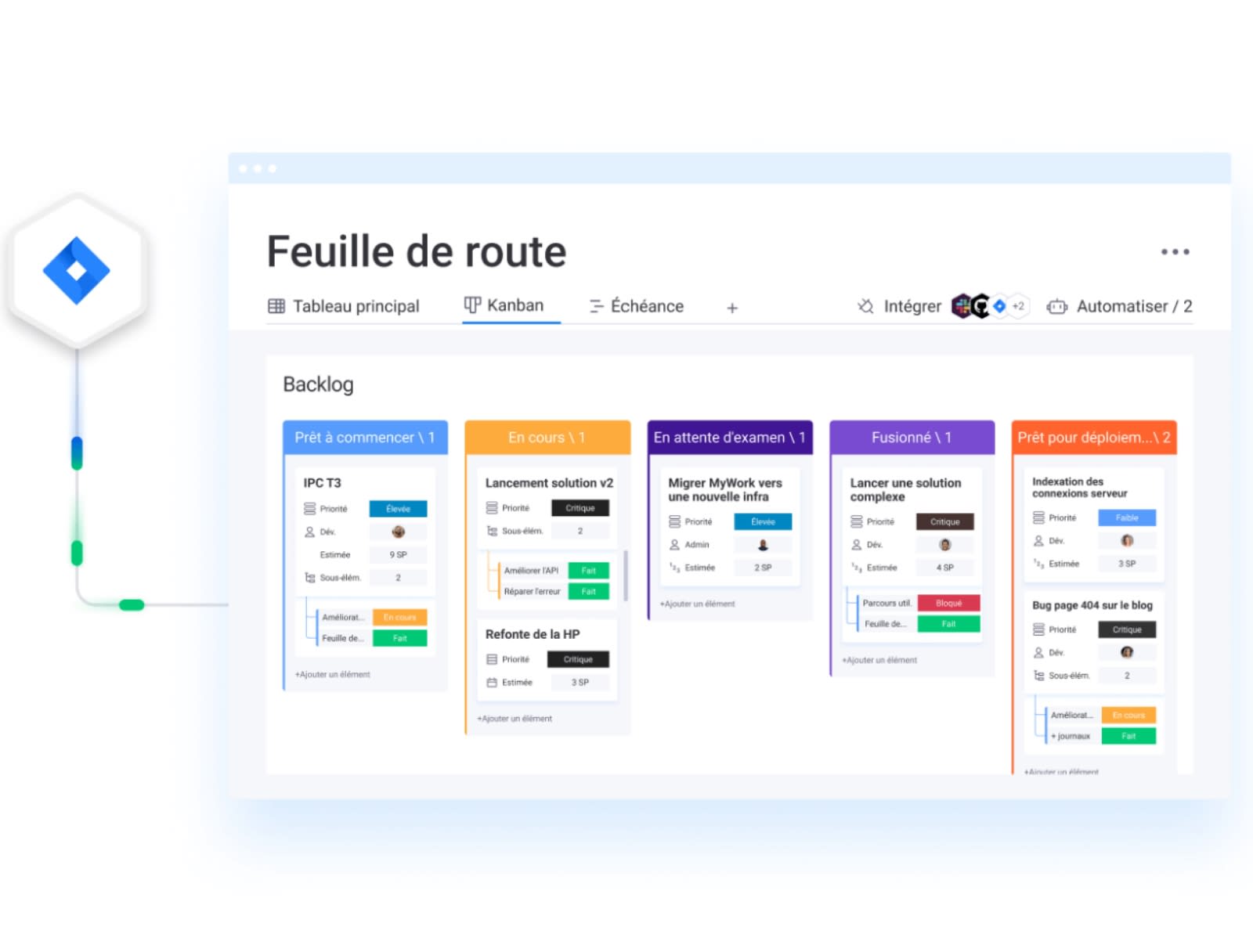
Ainsi, les tableaux Scrum comme les tableaux Kanban utilisent tous les deux des colonnes pour représenter les étapes du processus de travail et des cartes ou des post-its pour représenter les éléments de travail. Pourtant, le tableau Scrum est plus structuré et limité dans le temps, tandis que le tableau Kanban est plus souple et se concentre sur le processus continu et la limitation du travail en cours (WIP).
Tableau Scrum ou Kanban : processus continu ou par sprint
Les tableaux Scrum Agiles sont réinitialisés après chaque sprint. Ces derniers durent généralement de deux à quatre semaines. Ils reflètent donc le travail prévu pour cette itération spécifique. En revanche, les tableaux Kanban sont conçus pour un processus de travail continu, sans itération fixe ni remise à zéro.
Tableau Scrum ou Kanban : limites de WIP
Les Scrum boards peuvent avoir ou non des limites explicites de travail en cours (WIP) par colonne. En revanche, les tableaux Kanban ont des limites strictes de travail en cours (WIP) par colonne afin d’éviter la surcharge et de promouvoir un processus de travail régulier.
Tableau Scrum ou Kanban : objectif
Les tableaux Scrum se concentrent sur le suivi du travail au sein d’un sprint axé sur l’objectif du sprint. En revanche, les tableaux Kanban se concentrent sur la visualisation de l’ensemble du processus de travail et l’optimisation du débit de travail effectué.
Il est important de noter que Scrum et Kanban ne s’excluent pas mutuellement et que les équipes Agiles peuvent associer des éléments des deux méthodologies pour répondre à leurs besoins et processus de travail spécifiques. Cette approche hybride, appelée Scrumban, associe la structure de Scrum avec la flexibilité et la visualisation de Kanban. Or, l’utilisation d’une plateforme logicielle complète telle que monday dev, qui est à la fois un outil Kanban et un outil Scrum, permet d’utiliser les principales caractéristiques des deux cadres, y compris les tableaux visuels.
Essayer monday devCréez le tableau Scrum parfait avec monday dev
Construit à partir du Work OS de monday.com, monday dev fournit aux équipes produit et développement Agile tout ce dont elles ont besoin pour gérer leur planification, leurs sprints et leurs versions, de A à Z. Des Scrum boards aux indicateurs de performance, en passant par tout ce qui se trouve entre les deux, les équipes Agiles peuvent personnaliser leurs rapports en temps réel et suivre les progrès réalisés sur une plateforme unique.
Gérer efficacement ses sprints Scrum
Permettez à vos équipes de gérer ses cérémonies de sprint, de suivre les story points et de superviser le cycle de vie de ses sprints dans un tableau Scrum unique. De la planification de sprint et des stand-ups quotidiens à la rétrospective et aux revues de sprint, monday dev vous offre une vue à 360° de vos sprints Scrum.
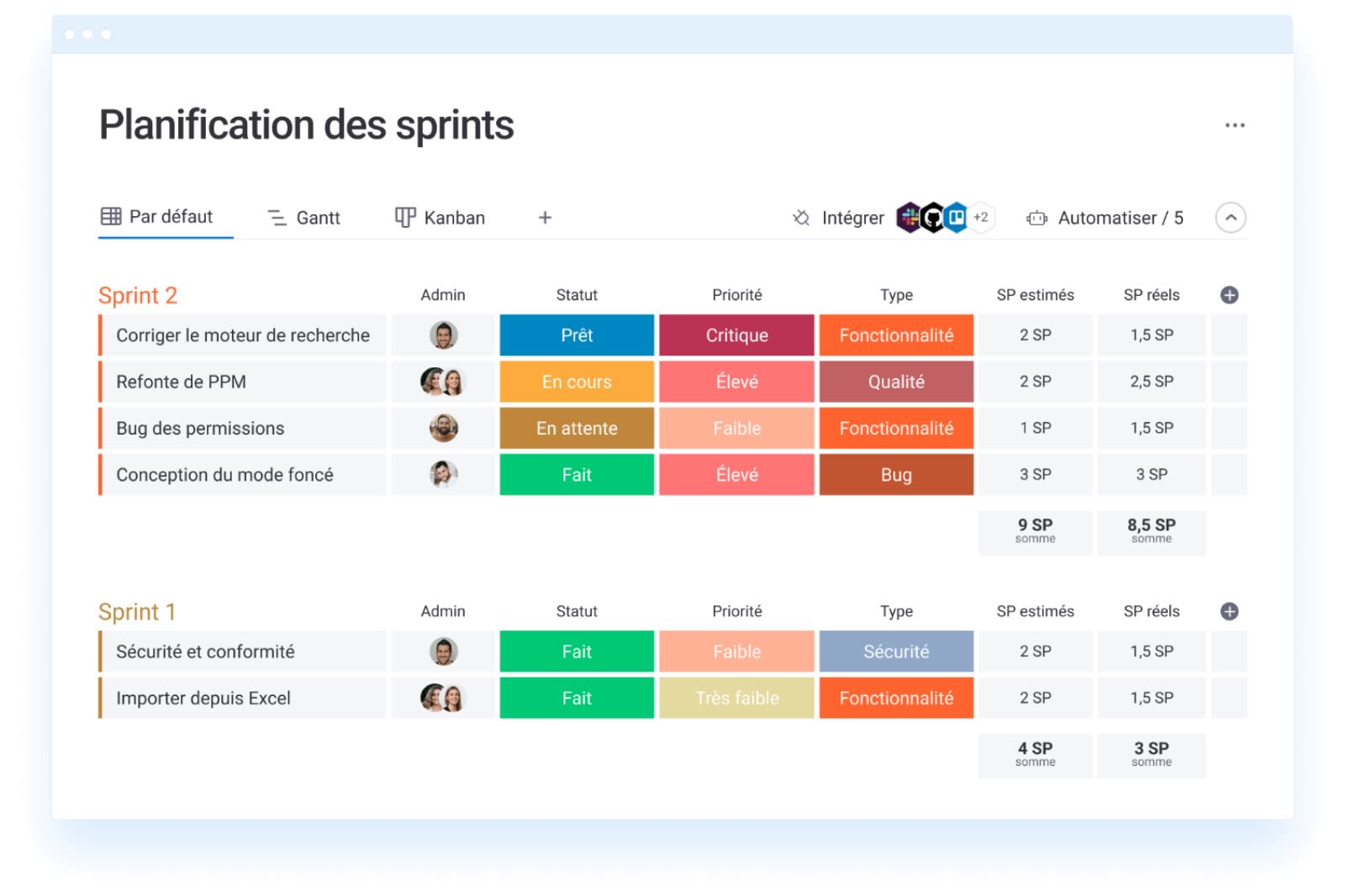
Intégrer facilement d’autres applications
Si vous construisez un nouveau produit ou que vous recueillez les commentaires des utilisateurs, vous pouvez facilement intégrer monday dev aux outils que vous utilisez déjà. Par exemple, vous pouvez intégrer GitHub et GitLab afin de synchroniser toutes les fonctionnalités et tous les bugs sur vos tableaux Scrum Agiles.
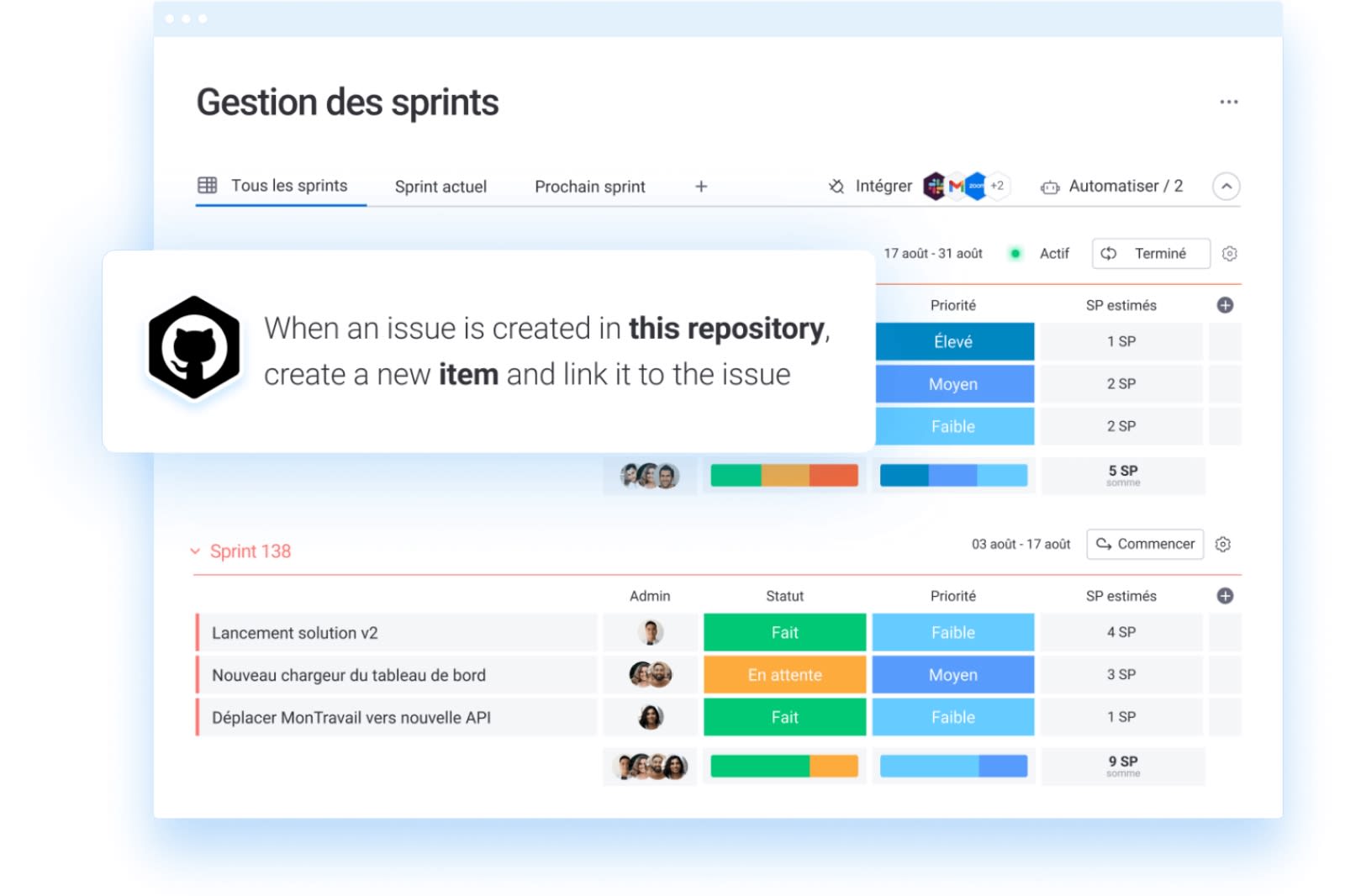
Automatiser les tâches répétitives en quelques clics
Gagnez du temps avec plus de 150 automatisations prédéfinies et personnalisables pour vous concentrer sur le travail qui compte vraiment. Choisissez parmi les recettes prédéfinies ou créez facilement une automatisation adaptée à vos besoins en quelques clics. Par exemple, créez l’automatisation « Lorsque le statut devient X, notifier quelqu’un » et gardez vos Scrum boards toujours à jour.
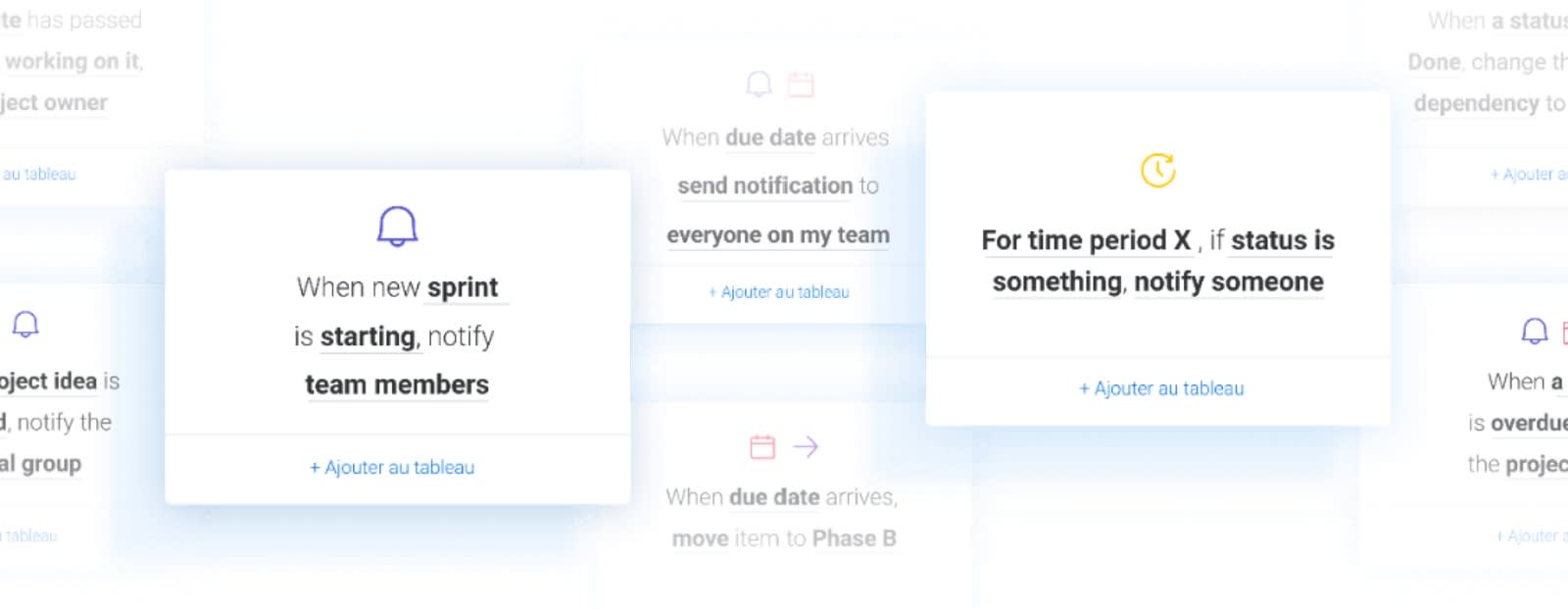
Personnaliser les tableaux de bord de sprint
Remplissez automatiquement des tableaux de bord personnalisés avec des informations aussi bien générales que détaillées provenant d’un maximum de 50 Scrum boards pour une prise de décision plus rationnelle.
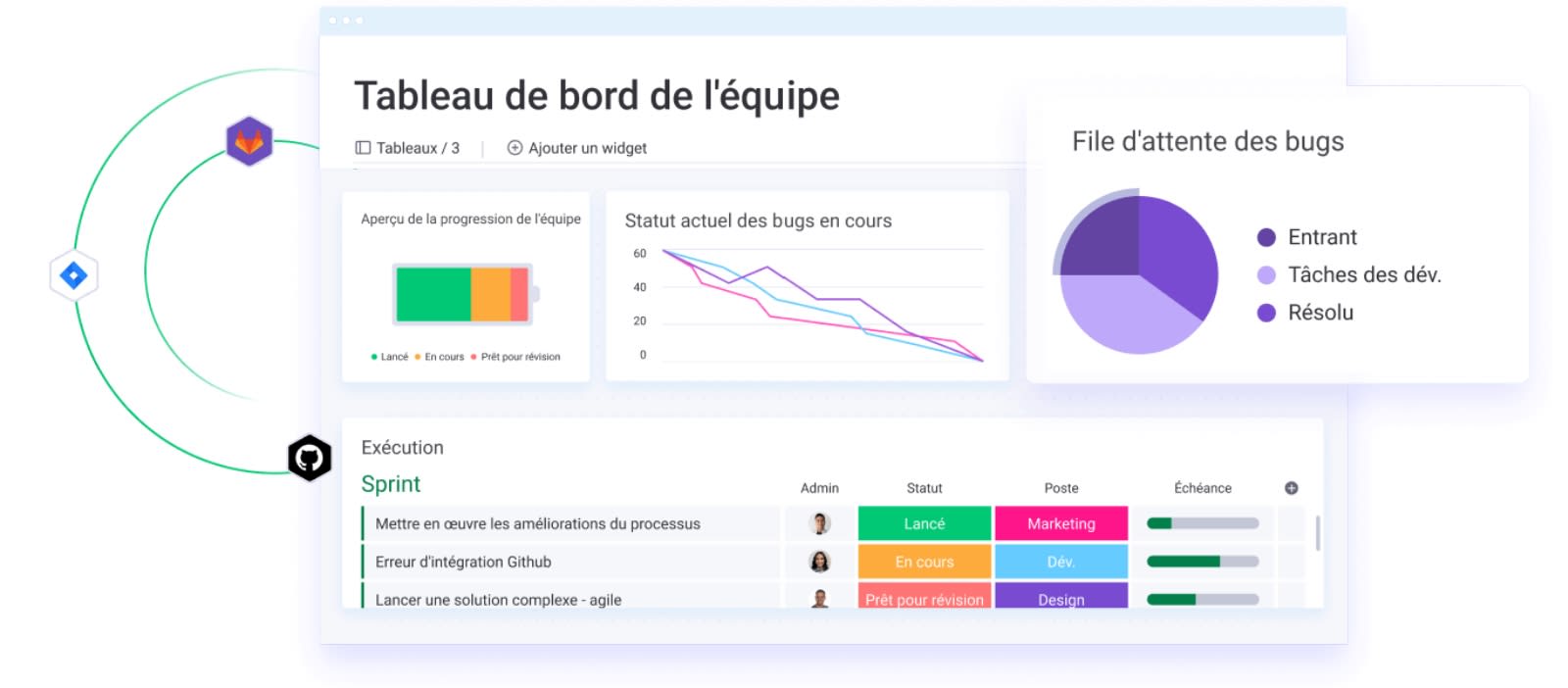
Produire rapidement des rapports Agiles
En utilisant monday dev, vous pouvez concevoir et personnaliser des rapports Scrum en temps réel, y compris des diagrammes de vélocité, des burnup charts et des burndown charts pour suivre la progression de vos sprints. Par exemple, utilisez un burndown chart pour détecter tout problème potentiel ou goulot d’étranglement en fonction de la progression réelle par rapport à la progression idéale dans votre tableau Scrum Agile.
Avec monday dev, votre équipe peut communiquer, fournir des mises à jour de statut, poser des questions, résoudre des problèmes, partager des informations et visualiser les progrès sur chaque Scrum board.
Essayer monday devFAQ
Quels sont les principes clés de Scrum ?
Outre ses trois piliers (transparence, inspection et adaptation) et ses cinq valeurs (engagement, focus, ouverture, respect et courage), le Scrum développe plusieurs principes clés indispensables pour une bonne gestion de projet Agile : le contrôle empirique des processus, l'auto-organisation, la collaboration, la priorisation basée sur la valeur, le respect des délais et le développement itératif.
Quel est le but d'un Scrum Board ?
L'objectif principal d'un tableau Scrum Agile est de fournir une représentation visuelle des éléments de travail et de leur progression au cours d'un sprint pour une équipe de développement Agile qui suit le cadre Scrum. Il permet aux équipes d'adopter les valeurs fondamentales de transparence, d'inspection et d'adaptation tout en favorisant la collaboration, la gestion efficace du processus de travail et l'amélioration continue tout au long du cycle du sprint.
Peut-on utiliser un tableau Scrum pour de la planification à long terme ?
Les tableaux Scrum sont principalement conçus et utilisés pour la planification à court terme des sprints plutôt que pour la planification à long terme. Les tableaux Kanban, les feuilles de route et d'autres outils de gestion de projet sont mieux adaptés à la planification à long terme et au suivi des progrès vers des objectifs organisationnels plus larges. Pour gérer aussi efficacement les sprints à court terme que les objectifs à long terme, les équipes Agiles utilisent souvent une combinaison de tableaux Scrum et d'autres outils de gestion de projet pour la planification à long terme.
 Commencer
Commencer 
Contactez nous 24 h/24

